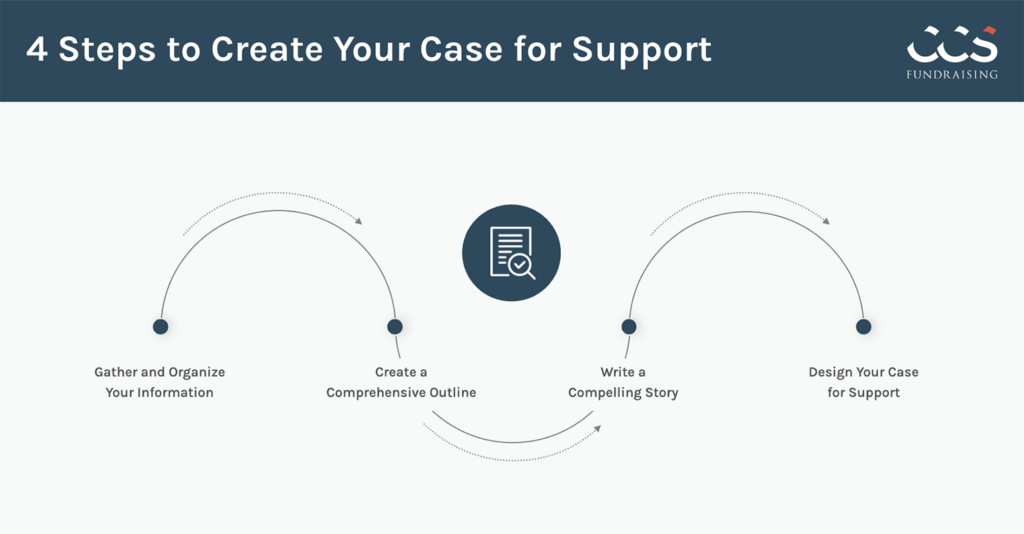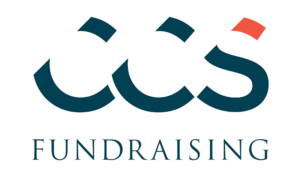As organizations prepare for a campaign, they often face competing priorities and limited resources—drafting a compelling case for support can seem overwhelming to add to the mix. But it is the guiding document for the entire campaign, so its importance cannot be overstated.
Mistakes Nonprofits Make in Case for Support Development
Misunderstanding the Purpose
An early mistake when writing your case is to misunderstand the document’s purpose. The case is not a stand-alone document and should instead be accompanied by a personal visit from a volunteer or organization leader.
The case is also the basis for all other campaign documents, including your website, major gift proposals, brochures, stewardship documents, and other collateral. Its design elements can create cohesive supporting materials, such as your gift agreement form, request letters, or mailings. Therefore, the content, tone, and design should be carefully developed with leadership and key stakeholder buy-in early in the planning stages of a major effort.
Forgetting the Audience
Another common mistake is not considering the recipient. The case is not a financial statement, strategic plan, or organizational manifesto. It should be written with actual donors in mind, including an emotional appeal about why the project matters and the impact a prospective donor can make. At its core, the case should show how the donor can be the hero in transforming their community by making a philanthropic investment.
Confusing the audience is a big mistake. Most donor prospects do not want to sift through text to find the campaign’s true meaning; they want a simple cause and effect (e.g., “By pledging $XX,XXX, this ‘something’ will happen in our organization).” Without concrete plans, the case is left up to interpretation by donors and volunteers, leading to a skewed perception of need, a misguided understanding of future goals, and money left on the table.
Leaving Money on the Table
With confusion comes the potential to leave money on the table. Donors want to have—and should have—a clear understanding of their money’s purpose. A donor may see the need for a campaign but not see the full picture due to a lack of detail or sense of need. As a result, that prospect may not feel compelled to stretch their dollars, and what could have been a $100,000 pledge may become a $45,000 pledge.
Making a Case for Want, Not Need
Lack of detail can sometimes leave donors thinking an organization has goals based on wants rather than needs—people give to needs. For example, if a case for support has a $1.5 million goal to renovate ABC School’s building, which of the below sounds like a need versus a want?
- ABC School is testing a $1.5 million goal to renovate the school building and fulfill our mission for future generations.
- ABC School is testing a $1.5 million goal to fix the HVAC system in the main school building, update the classrooms by installing computers, and replace the broken tile floors with sustainable Pergo flooring.
The first example gives a general idea of what will happen. Often, a Board of Directors will agree on this statement because the school building truly needs renovating, and they understand what that involves. However, a prospective alum donor not as close to the project may not know exactly why the school needs renovation. The second example explains exactly what the school needs and conveys a sense of need. Anyone who reads it can envision a school with no AC, crumbling floors, and no technology.
Mixed Messages/Speculation
Drawing from the ABC School example, consider how using the first example can lead to mixed messages. That prospective alum donor may think that renovating their alma mater is a super idea; they want to support their school and give future students the best opportunities and education possible. When they ask the question: “What renovations are needed,” more often than not, the answer to this question may be, “It depends on how much money we raise.” Trained volunteers may leave out a few elements or add in other projects that may occur if enough money is raised. Specific case elements and details help guide the campaign and the volunteers in conveying the organization’s plans. The two essential questions that need to be answered are: what are we raising money for, and what is the expected outcome?
No Sense of Urgency
A lack of specificity translates to a lack of urgency. If an organization wants to test the idea of a campaign without having specifics, why should a donor feel compelled to give when there is no specific pressing need? Part of the case for support includes defining the situation of today and the need for the future. Combined with a realistic timetable, these two fundamentals will convey that sense of urgency and instill trust in potential donors.
Lacking Good Design or Editing
Poorly edited or designed documents detract from the project’s gravity and impact and make it painfully clear that insufficient time and effort was spent. To avoid this misstep, proofread your document at every turn and ask others internally to read it carefully before presenting it externally. Similarly, a poorly designed document reflects a lack of effort or thought—case statements should be visually appealing to grab readers’ attention and describe the campaign’s importance.
Planning for a successful case
Preparation is invaluable when crafting the ideal case for support. Before you put pen to paper, consider these preliminary steps.
Determine Your Organization’s Strategic Priorities
Internal discussions and decisions shape a major fundraising effort, including strategic planning or visioning sessions, which are a natural guide for developing funding priorities. Some organizations try to do too much and, as a result, find out too late that they should narrow their focus and better prioritize funding their needs and wants. Other organizations may limit their capabilities too severely by underestimating their reach or insufficiently conveying their missions. It is important to think strategically from the onset to avoid these pitfalls.
Conduct a Feasibility or Planning Study
Often, conducting a feasibility and planning study can help uncover funding priorities that resonate with donors. This is your opportunity to ask stakeholders what is important to them and determine your community’s appetite for funding various projects.
Estimate Costs and Analyze Impact
Other critical areas of planning include creating cost estimates and quantifying impact. Savvy donors are influenced by the cost of funding different projects and their gift’s impact on your organization and community, so you should be prepared to present this information in the case.
These early steps should be taken internally with a small strategic planning committee or your board. Once you have a general outline of your plan and funding needs, it is time to begin writing your case.
Review Case for Support Examples
Another important planning step is to look to successful case for support examples for inspiration. Two CCS Fundraising examples were recently winners of the firm’s Excellence Award:
steps for creating YOUR NONPROFIT’S CASE FOR SUPPORT
1. Gather and Organize Your Information
Gather current information about your plans, funding areas, and costs. Cast a wide net to include the following.
- Organizational information (i.e., mission, vision, strategic plan, branding guidelines)
- Program or project details/schematics
- Cost estimates
- Impact stories
- Quotes
- Photos/renderings/visuals
Categorizing and organizing your information before you begin writing reveals gaps and allows you to begin outlining your content and vision in a way that makes sense and is true to your organization.
2. Create a Comprehensive Case for Support Outline
After collecting information, create an outline of the content of your case statement. To start, answer the following questions using the information you collected.
- What issues does your organization target (mission)?
- What are your organization’s strengths?
- What challenge or obstacle do you face? How do you propose to overcome this obstacle?
- What are your funding needs?
- What will be the impact of fulfilling those funding needs? How will this change the community?
- What are you asking of the donor?
Your outline should include relevant details and be a relatively high-level organization overview, describing the challenge your organization faces, your future vision, and the impact the donor can make. Include only the most essential information and leave out anything irrelevant to your audience.
3. Write a Compelling Story
Using the outline you created, supplement your content with compelling language to motivate prospective donors to see themselves as an active participant in overcoming your organization’s challenges. An effective case for support includes an accurate description of how the donor will create transformational change. The closing should incorporate a “call to action,” a final invitation that propels the donors along the engagement pipeline.
4. Design Your Case for Support
The design of your website and collateral matters for how the public views you; 94% of first impressions are design-related.
After creating a compelling story, begin designing your case for support. Your organization may have defined branding guidelines—if so, use them to ensure your case is recognizable and aligned with your organizational culture.
If you have limited resources, designing your case for support can be challenging, but keep the following in mind.
- You can design using PowerPoint and draw inspiration by searching for other case statements.
- Be consistent with text size, margins, alignment, and other small details. Uniformity demonstrates professionalism and the document’s importance to prospective donors.
- High-quality photos can convey information more quickly and effectively than text. Consider taking new photos or using compelling stock photos that align with your mission.
- Use design elements such as bolding, titles, text boxes, and color to emphasize important information.
Finalizing a strong case
Writing your best case requires meticulous planning, drafting, designing, and editing. Along the way, you should share case iterations with other team members, volunteers, and prospective donors. Asking your stakeholders for feedback and building consensus throughout the case’s development prevents setbacks and builds familiarity throughout the organization. Likewise, following the steps sequentially is important, as jumping ahead is counterproductive and can create additional work.
As you begin, keep impact at the top of your mind. Drafting your case can seem overwhelming, but it is also exciting. You are embarking on a process that can create a ripple effect in your community and make a long-term difference for your organization. Bring that passion, excitement, and vision for the future with you as you create your most compelling case yet!
More Insights
November 29, 2023
Did you know that 31% of annual giving occurs in December, with 12% taking place in the last three days of the year? Does your non-profit organisation have a strong year-end strategy to take advantage of these powerful trends? Read our five steps to maximise the success of your year-end fundraising appeal.
August 29th, 2023
Featuring essential philanthropic research from all major sources in the industry, this exclusive report examines key themes in American philanthropy and the latest data on giving by US individuals, foundations, and corporations.














